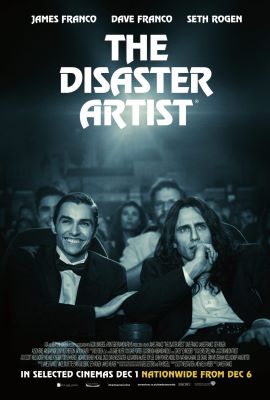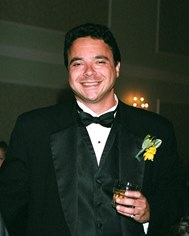 In producing, directing and starring in “The Disaster Artist,” the true story of filmmaker Tommy Wiseau’s ‘so bad-it’s good’ 2003 film “The Room,” James Franco has made a passion play where the passion shines through. Anchored in his thoughtful portrayal of the mysteriously odd and eccentric wanna-be celebrity Wiseau, Franco has chronicled the unlikeliest of success stories.
In producing, directing and starring in “The Disaster Artist,” the true story of filmmaker Tommy Wiseau’s ‘so bad-it’s good’ 2003 film “The Room,” James Franco has made a passion play where the passion shines through. Anchored in his thoughtful portrayal of the mysteriously odd and eccentric wanna-be celebrity Wiseau, Franco has chronicled the unlikeliest of success stories.
In the late-1990’s, Greg Sestero (Dave Franco) was an aspiring actor in San Francisco whose future seemed bleak, never more evident than in an acting class where he’s berated by his acting teacher (Melanie Griffith) for not being believable. Dejected and depressed, Greg returns to his seat only to be followed onstage by Tommy Wiseau (James Franco), whose exaggerated feral and frantic reading of Stanley Kowalski in “A Streetcar Named Desire” can only be summed up by acting coach Griffith as “that’s interesting.” Sensing Tommy’s emotion may be the key to allow him to emote, Greg approaches Tommy in the parking lot after class and asks him to run lines. During a makeshift acting workshop in a diner, Tommy’s enthusiasm in line readings infects Greg until he reaches Tommy’s same level of loudness. While the surrounding diners applaud the audacity, Greg becomes convinced what they’ve just done has been authentic thespian therapy.
Bolstered by Tommy’s training and learning of Tommy’s equal longing for celebrity, Greg talks of moving to Los Angeles to pursue his dream of acting. Tommy offers Greg the opportunity to be his roommate in Tommy’s already-owned L.A. apartment. Wait, Greg wonders…how can Tommy be a struggling actor and have two apartments? Also, how can Tommy claim to be in his late-teens, like Greg, when he’s clearly older and say he’s from New Orleans when his accent borders on Eastern European? Given that he may have found his acting guru or maybe that Tommy’s affable eccentricity trumps his enigma, Greg accepts Tommy’s offer and the two embark to L.A. to secure their stardom. Once there, the struggling artists learn that sometimes you have to create your own opportunity to succeed: Tommy suggests they write and star in their own movie. In addition to the mysteries already surrounding Tommy, Greg realizes Tommy can somehow finance his own film (eventually spending $6 million on the script he’s written to direct called “The Room”) with Greg and Tommy starring in the lead roles. The chain of events leading to the completion of Wiseau’s cult fave film is what Franco’s “Disaster Artist” explores.
On its surface, “Disaster Artist” is a lot like a modern-day “Ed Wood,” Tim Burton’s 1994 film that starred Johnny Depp as the real-life Wood, whose ambition to be the next auteur like “Citizen Kane’s” Orson Welles conflicted with Wood’s tenuous talent for using stock footage and cheap production values to make badly-crafted yet lovable ‘50’s B-movies. However, Franco also manages to pepper his “Disaster Artist” with scenes that include former co-stars and celebrity friends in supporting roles (joining the aforementioned Griffith are Seth Rogen, Sharon Stone, Judd Apatow and more) to give “Disaster” a real “This is Spinal Tap” feel. This “Tap” tendency toward absurdity is a fun boost to “Disaster,” particularly when showing “The Room’s” production phase: script supervisor Rogen questions why Tommy would build an in-studio set for an alley when there’s an alley behind the studio; Tommy hires a behind-the-scenes crew to film the actual film crew- after his crew talks behind his back, Tommy alerts them to the secret crew’s presence, warning them he can “hear the whispers of their souls.”
While the “Ed Wood/Spinal Tap” vibe is inviting, its Franco’s performance as Tommy Wiseau that makes you invested. In a lot of ways, Franco’s portrayal of Wiseau could have been cartoonish: an appearance that’s retro-‘80’s (complete with Milli Vanilli shoulder-padded jackets) with a speaking-accent like Bronson Pinchot’s Serge in “Beverly Hills Cop.” Yet despite our disbelief in Tommy Wiseau’s claims, we buy into Tommy (in much the same way Greg must have in real life) because Franco embraces Wiseau’s delicate, misguided and amiable core. Making you believe Tommy’s honest desire for stardom and his wish to share his success with those close to him is what Franco brings out in Wiseau’s character (were it not for that, Greg’s initial impulse to follow Tommy to L.A. or have us buy into Wiseau’s highly-unlikely back-story would have backfired). As implausibly as it must have happened, Franco makes us understand by giving Tommy a tender restraint beneath the overtly odd. Backed by Scott Neustadter and Michael H. Weber’s screenplay (“500 Days of Summer,”“The Spectacular Now”), Franco’s acting is vindicated.
While Wisaeau achieved audience approval for those who relished ridiculing “The Room” (making its money back as a cult commodity), Franco’s accolades for “Disaster” are more deserving. Already winning independent film awards for his acting, Franco also directs what’s obviously a labor of love (the closing credits reveal how uncannily his replicated ‘Room’ scenes are to Wiseau’s own). Franco may have flirted with disaster by juggling a lot of the film’s duties (as the real Wiseau’s auteur inspired) but his portrayal of Wiseau, like the film itself, shows what this ‘disaster’ is really all about: an ambitious and open heart always wins out.
